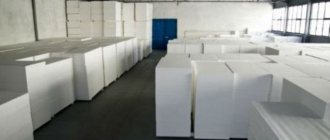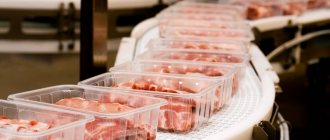Technological stages
The production of sweets is divided into several stages.
- The very first is preparing a mass of sugar, molasses, agar, water, butter, milk and flavorings. Depending on the type, its composition and the temperature at which the ingredients are mixed and acquire the desired consistency are determined.
- The next stage is the formation of the candy. The most common method is casting the mass into starch. It allows you to make many types of candies. When pouring, the fondant needs 70 degrees; milk and fruit filling – 100; jelly on agar - 75, on pectin - 95, on carageenan - 80. The production of sweets with liqueur filling is possible at 95 degrees. For formation, sifted and dried corn starch is used. In addition to forming the candy body, it also participates in removing excess moisture from the surface by absorbing it.
- The third stage is glazing. Candy production may or may not involve this process. Glaze is needed to ensure that the product remains fresh longer, not hard and dry. It can also be chocolate. Confectionery glaze does not become covered with a whitish coating, since it does not have fatty subsidence. But real chocolate is not immune to this. Although such plaque is harmless, the appearance can be spoiled.
- Drying completes the production of candies. It is carried out in special chambers with the possibility of cooling for the fastest structuring of the body and hardening of the glaze or chocolate. Then all that remains is to pack the delicious products into wrappers or boxes.
Chocolate making business ideas
There are two models for organizing the technological process: home or industrial chocolate production.
By choosing the first option, you can start a business at home in the kitchen, investing a minimum of money in equipment. But it will not be possible to officially register such a business, so the responsibility for working without registering with the Federal Tax Service and paying taxes will fall on you.
In the second case, you will have to comply with the requirements of inspection authorities, rent and prepare a workshop, hire employees and establish a stream production of chocolate products.
Making handmade chocolate
“Chocolate boutique” is a concept that came to Russia in 2020. The boutique sells elite handmade chocolate made according to home recipes. The owners of such establishments rely on the uniqueness of their products, inferior to large workshops in production volumes.
The assortment of the chocolate boutique includes:
- dark, white and milk chocolate bars;
- chocolate with fruit and berry fillings;
- truffles;
- candies with non-standard fillings;
- gift sets of different types of chocolate.
Customers can order personalized sets, chocolate fountains and even engraved chocolates.
The fashionable trend of gourmet boutiques is the combination of incompatible tastes. Luxury chocolate manufacturers offer ginger, chili peppers, candied fruits and even bacon as fillings. They sell flavored candies exclusively in original packaging.
Handmade chocolate is a delight for gourmets, so it will always find its buyer
Making fruits in chocolate
Strawberries, apples and bananas are fruits that are in demand all year round. In combination with chocolate they form a unique delicacy. The advantage of the chocolate-covered fruit business is minimal competition on the Russian market. The disadvantage is the pronounced seasonality. In winter, the cost of fruit increases, and consumer demand decreases.
A possible way out of the situation is to rent space in a city shopping center in order to work even in the cold season, in a place with maximum traffic. Advertising can focus on the vitamin content of products.
There is nothing tastier than chocolate-covered fruit: neither children nor adults can resist this delicacy.
Making chocolate figures
The technology for making chocolate figurines is simple - hot chocolate is poured into molds, then cooled until hardened and the halves are removed. The edges of each are carefully heated and glued together. Figures are used to decorate cakes and pastries and are given as gifts for children and adults on holidays.
To prepare a chocolate butterfly or openwork lace you need:
- melted chocolate;
- glass bowl for heating;
- Silicone forms.
Instead of molds, you can use any objects: cups, shot glasses, spoons, paper sheets and others. By combining different types of chocolate and adding food coloring, confectioners give the figures a unique design. Show your imagination and an unprecedented result will not keep you waiting.
Chocolate figurines are ordered to decorate wedding and anniversary cakes
Ingredients for candy production
This type of sweet consists mostly of sugar. Sweets may also contain molasses, berries and fruits, honey, nuts, sunflowers, and sesame. In addition, cocoa liquor, cocoa butter, cocoa powder, dairy products, wine, coffee and vanilla. Components such as fats of animal origin, less often of vegetable origin, and eggs are also included in the composition of the candy mass, which can be very different.
- For example, fudge uses a syrup made from sugar. Sweets are prepared by boiling it with molasses.
- If you add milk, you get milk fudge, and if you add baked milk, you get creme brulee.
- Dairy fillings differ from fudge in their higher content of this product. Fruit mass is obtained by boiling fruits and berries with the addition of flavorings and aromas.
- Jelly fillings consist of sugar, molasses, gelatin or agar. Fruit and berry raw materials are often added.
- Praline and nut fillings consist of roasted nuts, sugar and fat. The aerated mass resembles gelatinous foam and is prepared from sugar-treacle syrup, egg whites, agar and flavoring additives.
- The filling for grilled meat includes fruit mass or sugar and crushed nuts. Marzipan candies are prepared by grinding almonds with molasses and powdered sugar.
- Cream fillings consist of mixed and whipped chocolate, fondant and praline mixtures with fats. Liqueur additives are prepared from sugar, alcohol solution and flavoring additives.
Equipment for making candies
The required equipment for making sweets depends on finances, scale and focus. To make the simplest sweets, an ordinary kitchen equipped with a stove, baking molds and a pastry syringe is suitable. Baking dishes and a syringe can be purchased for pennies on various trading platforms (AliExpress, eBay, Alibaba). All expenses revolve only on the purchase of ingredients, but they do not require large investments if they are purchased in bulk and do not create complex dishes.
Equipment
The candy mass is cast into starch using a special candy casting machine. Piston pumps deliver the mixture through a heating funnel. Equipment for the production of candies from fondant, fruit, jelly and milk mass is equipped with a gear pump. It is used to pump the mass into the funnels of the casting machine.
The liqueur and whipped mixture is loaded manually. Special equipment for the production of candies stamps cells of various shapes and sizes. It is used to prevent the structure of products in trays from being destroyed.
To store products, a warehouse with a temperature of 20 degrees and humidity of up to 75% is used.
Confectionery market analysis
The market for confectionery and chocolate candies (chocolate) is resistant to economic downturns. Gifts and purchases for children, gifts and personal preferences make this product segment quite popular among the broad consumer masses.
At the moment, the Russian market, in particular the chocolate candy production business, is represented by a wide range of products in the form of chocolate: milk, porous, black or regular with various fillings; chocolates of the most varied shapes and fillings. In terms of value, the sales segment of chocolates and bars accounts for 1/3 of the total sales of confectionery products.
It should be noted that the production of chocolates depends on the season ; at the time of the greatest surge (holidays and pre-holidays), production can increase by 300%. The rest of the time, the enterprise can only be loaded at 30-60% of the planned capacity.
The most popular product is loose candies and chocolate bars; sales are represented by regional representative offices of large confectionery companies. This has its advantages: the costs of delivery and payment for office representative offices increase the cost of their products by 6-8%.
For example, Nestle candies have a cost price of $3 per 1 kg; their sales in the regions are $8 per kilogram. Producing sweets in your region makes it possible to reduce the price of your own goods of high consumer demand.
Consumer behavior towards confectionery products
65% of buyers are active buyers of chocolates and chocolate, regardless of the season, buying these products 3-4 times a week, and 20% are less active, buying once a week. Thus, taking into account the population in the region, it is possible to calculate in advance the volume of production of chocolates and chocolate bars.
Caramel making technology
The process consists of preparing the mass, cooling it, dosing, rolling and molding, dividing the layer into candies, and feeding it into packaging. Initially, the moisture content of molasses caramel syrup is about 15%. During the boiling process, it decreases tenfold.
Then the resulting mass is molded and cooled to 45 degrees, wrapped in a wrapper, packaged in bundles and packed in boxes. The technology for producing caramel candies requires the presence of a digester with a stirrer, an intermediate container, a temperature table, forming rollers, a conveyor-type cooling machine, a vibrating tray and packaging tables. This line has a capacity of 150 kg of caramel per hour and costs approximately 1.3 million rubles.
Project production plan
1. Rental of premises: production workshop and warehouse. Mandatory drawing up of an agreement according to the established regulations. Construction of additional structures (office and household premises), rental of transport for delivering products to retail outlets.
2. Installation and installation of the necessary equipment, commissioning work, launch of the production line.
3. Production process of candy production.
The candy production technology consists of several stages:
- mixing individual fondant ingredients;
- cooking process; — molding or casting fondant into special oval shapes; — running molds through cooling systems; — glazing of sweets with chocolate fudge; - cooling; — packaging of products in wrapping paper.
Chocolate bar production technology:
- mixing the ingredients of the chocolate mass;
- cooking process;
- casting into special molds;
- run through the cooling system;
- packing tiles in wrapping paper.
Equipment for the production of chocolates
It should be noted that the candy production line consists of four sections, each of which has its own range of equipment:
1. Area for the production of candy mass:
- universal cooking apparatus, used for cooking, mixing and emptying the mass, with automatic control;
- weighing device for dosing components of fondant or chocolate mass;
- loading pump for supplying mass to the casting;
- dosing pump for flavourings, acids, fudge and chocolate colours.
2. Casting installation:
- installation of One-shot casting with servo drive and electronic control;
- conveyor of molds for casting;
- cooling cabinet, including control distribution cabinet and cold air preparation station;
- forms.
3. Candy production line (for enrobing shells):
- table for feeding products to the glazing machine;
- enrobing machine;
- pump for return flow of excess mass.
4. Automatic candy wrapping packaging line:
- distribution conveyors for supplying candies to storage areas.
The technological scheme for the production of chocolate candies and chocolate bars is quite complex and requires highly qualified personnel and well-functioning equipment.
The cost of purchasing equipment and renting premises is about $50,000, which is the starting capital. The estimated time of self-sufficiency and profitability of the enterprise is 5-8 years. The expected profit per year is 36% of the starting capital.
Truffle preparation technology
A similar amount will be required to purchase equipment for the production of truffle sweets. They are made from cocoa, iris essence, and coconut oil. The process of creating truffles consists of the following operations: preparing the candy mass, tempering (the production of chocolate candies cannot be done without it), forming the body, cooling, sprinkling with cocoa powder, finishing and packaging.
The production line is made of a digester, tempering machine, churning, depositing, cooling conveyor equipment, glazing machines, steam generator, conveying belt for feeding products for stacking. It has a productivity of 150 kg per hour and costs from one to one and a half million rubles. The equipment usually pays for itself in 6-8 months.
Example of financial calculation
The financial performance of the project directly depends on the area of activity. Candies that require a more expensive production line will generate more profits in the future because they cost more. And, for example, a dragee, which is produced on relatively inexpensive equipment and using budget raw materials, has a several times lower price. Therefore, when choosing the type of sweets produced, you need to work through and calculate all these points in order to determine the best option for yourself.
Start-up investments
The bulk of financial investments in the business will be directed to the purchase of equipment. Taking into account the above-described features of all lines, the cost of each of them will be as follows:
| Category of produced sweets | Mini-line cost, rubles |
| Lipsticks | 900000 |
| Caramel and lollipops | 1200000 |
| Truffles, other chocolate sweets | 1500000 |
| Dragee | 250000 |
The second major item of start-up investment is the purchase of raw materials. Money to purchase the first month's supply of all necessary ingredients will also have to be spent before starting the activity.
Based on the indicated productivity of the considered lines of 150 kg/hour, an enterprise operating in one shift (8 hours) will produce 1200 kg of products per day or 27 tons per month. To obtain such a quantity of sweets, you will need basic raw materials of appropriate weight, including:
| Type of raw material | Required quantity, kg | Price per 1 kg, rubles | Total cost, rubles |
| Granulated sugar | 25000 | 40 | 1000000 |
| Cocoa powder | 5000 | 100 | 500000 |
| Cocoa butter | 5000 | 120 | 600000 |
| Powdered sugar | 1000 | 60 | 60000 |
| Additional components | 1500 | 200 | 300000 |
| Total | 3000000 |
Thus, the purchase of basic raw materials will require 2,000,000–3,000,000 rubles. The only exception is the production of dragees, which mainly contain only sugar and water, as well as some flavoring or coloring additives. Therefore, the cost of raw materials for this type of candy will be about 1,000,000 rubles.
Also, to install a technological line for the production of pellets, a small area is required. Therefore, the rent for it will also be much lower.
In general, all costs of organizing a candy business can be summarized in the following table (in rubles):
| Article | Amount, rubles |
| Legal procedures (for individual entrepreneurs): payment of state duty paperwork logo development | 5000 800 200 4000 |
| Arrangement of premises: repair furniture and office equipment for administrative staff warehouse equipment | 400000 200000 150000 50000 |
| Rent | 50000‒100000 |
| Purchasing a mini line | 250000‒15000000 |
| Purchase of raw materials | 1000000‒3000000 |
| Materials for packaging/packing | 20000 |
| Advertising and Marketing | 95000 |
| Unexpected expenses | 100000 |
Taking into account the features described above, the starting investment for opening a business producing each type of candy will be:
| Candy category name | Investment amount, rubles |
| Truffles, other chocolates | 5300000 |
| Lipsticks | 3900000 |
| Caramel and lollipops | 3000000 |
| Dragee | 1920000 |
The least expensive investment is the production of dragees. This option can be chosen for a startup with limited financial resources.
Current expenses
Every month you will have to purchase a new batch of a month's supply of raw materials, as well as pay wages to employees and make other payments. For an enterprise operating on one shift, the following minimum wage fund will be required:
| Job title | Amount of workers | Salary, rubles | Total payroll, rubles |
| Manager | 1 | 40000 | 40000 |
| Accountant | 1 | 35000 | 35000 |
| Technologist | 1 | 35000 | 35000 |
| Line Operator | 4 | 30000 | 120000 |
| Handyman | 2 | 20000 | 40000 |
| Total | 9 | 270000 |
Taking into account all other ongoing payments, the total monthly cost will include:
Article Amount, rubles Rent 50,000 - 100,000 Raw materials 1,000,000 - 3,000,000 Materials for packaging/packaging 20,000 Payroll 270,000 Taxes 300,000 - 800,000 Utilities 200,000 Advertising and marketing 60,000 Unforeseen expenses 100,000 Total 20,000 00‒4550000
Summarizing these items separately for each type of product, the following funds will need to be invested monthly for a specific production:
| Categories of produced sweets | Amount of expenses per month, rubles |
| Truffles, other chocolates | 4550000 |
| Lipsticks | 3400000 |
| Caramel and lollipops | 2800000 |
| Dragee | 2000000 |
Income
The easiest way to calculate the revenue part is by the cost of production. Based on production volumes of 27,000 kg per month and the indicated monthly costs, the following figures are obtained:
| Candy category name | Sales price, rubles | Revenue per month, rubles | Net profit, rubles |
| Truffles, other chocolates | 200 | 5400000 | 850000 |
| Lipsticks | 150 | 4050000 | 650000 |
| Caramel and lollipops | 120 | 3240000 | 440000 |
| Dragee | 85 | 2295000 | 295000 |
Theoretically, the starting investment for each of the indicated areas of activity will pay off in 6–8 months. But all calculations are given taking into account the operation of the enterprise at full capacity and the monthly sale of 100% of the products produced. It will not be possible to reach this level immediately, but only after 8–10 months of full-time work. Therefore, in practice, the payback period is approximately 14–16 months.
The candy business discourages newcomers due to the complexity of the technological process, high competition and excessive dependence on the availability of distribution channels. It should be taken into account that sweets are in consistently high demand; the main thing is to choose your niche correctly, focusing on the presence of competitors and the purchasing power of potential consumers. To do this, you need to carefully study the market and draw up the most specific business plan that minimizes all possible risks.
Rate this page: 1 ratings, average: 5.00
- #: Business for men
- Food and drink
- Production
Dragee preparation technology
The cheapest line for making small round sweets coated in sugar. A dragee is a body with an outer coating rolled onto it. This is done in a special rotating boiler installed at an angle. First, the base is prepared, which is then panned and glossed.
Finished products are packaged and packaged. This is the simplest and cheapest production, including a micromill, a digester, a coating drum, a sugar sifter, and a packaging machine. Such a line costs 200 thousand rubles and produces 100 kg of product per hour. To install it, you will need a room of 30 m2, and only three people can operate it.
Candy Manufacturing Business
Entrepreneurs who do not have large start-up capital can first choose one direction. For example, organize a business - the production of caramel sweets and dragees or chocolate products and truffles. Subsequently, as profits grow, you can add one or more lines to expand the range.
Large factories use production capacities of 1000 kg of candy per hour. But you can start with equipment producing from 150 kg/hour. Mini-lines of Russian and foreign production are quite popular among entrepreneurs. Compact placement and affordable prices allow them to be purchased from the first profits.
Organizing a business step by step
Registration of activities, documents
It is necessary to start a business by registering a business activity - individual entrepreneur or LLC. For a mini-factory or even a medium-sized candy production workshop, the status of an individual entrepreneur is quite sufficient. This is more convenient in terms of reporting, paying taxes and is cheaper when registering activities (state duty is 800 rubles).
LLC is relevant when organizing a large business or if the project has several sponsors and potential owners. In this case, a legal entity is registered - a limited liability company, in which each founder is allocated a share in accordance with his investments or at the discretion of all members of the organization.
The procedure for registering an individual entrepreneur and LLC is identical:
- collection of documents - passport, TIN, application, paid state duty receipt. For an LLC, you will need a decision to establish a company, a charter, a bank account with a capital of at least 10,000 rubles;
- submitting documents to the tax service;
- obtaining a certificate of registration of business activity.
Organizational events do not exceed 5 days.
Before starting the production of sweets, you need to visit Rospotrebnadzor with documentation on the manufacturing technology of the products. The organization will issue a quality certificate. In the future, you should prepare for scheduled inspections by the fire inspectorate and sanitary service.
Production room
The area of the premises depends on the volume of products produced. For example, if the production of one type of candy is intended, then 50-60 sq. m. will be enough to install equipment and provide comfortable work for employees. m. Otherwise, the area of the premises increases in proportion to the volume of production.
Location – city limits or industrial zone with convenient access for trucks and a short distance from transport links.
Help: if you plan to wholesale or retail products directly from a warehouse, it is recommended to find premises within the city to attract more customers.
Equipment
The set of equipment for a candy shop depends on the type of products produced. What is required:
- cutting tables;
- refrigeration equipment;
- transport line;
- packing machine;
- containers for mixing ingredients;
- molds for various types of sweets;
- tempering unit;
- office furniture;
- computer technology.
Formation of an assortment of sweets
A mini-shop for the production of sweets compares favorably with large plants and factories in that it can afford to experiment with volumes and range of products. If large brands are aimed at mass production, then private enterprises are famous for individual products.
An entrepreneur can produce well-known types of sweets, such as caramels or chocolate bars, or produce sweets according to his own recipe in unique packaging. Such an approach to business will have a positive impact on the formation of a target audience and the development of a personal brand.
Purchase of raw materials from suppliers
Ingredients can be purchased from one supplier or from several at once, which depends on offers, price and quality of raw materials.
For candies you will need:
- cocoa beans - raw materials are supplied from Asia, Africa and Australia. In addition, you can use ready-made cocoa powder produced in Russia;
- sugar, milk, butter - ingredients whose supply will not pose any problems;
- filling - nuts, raisins and others can also be purchased from regional or direct suppliers.
Various additives (thickeners, flavor enhancers) are sold everywhere, from wholesale stores to manufacturing plants.
Staff
For a mini-workshop you will need:
- technologist;
- confectioners;
- general workers;
- cleaners;
- security guards;
- drivers;
- office employees;
- accountant.
The number of positions depends on the scale of production. Each employee must have a valid health certificate. Upon employment, personnel sign a non-disclosure agreement on trade secrets, and in particular the recipe for the production of sweets.
Possible product sales channels and advertising
The most effective advertising methods for a candy business are:
- outdoor advertising using the company logo, name and product representative. If a certain type of candy is in front of people’s eyes, then buyers on a subconscious level will pay attention to the products in stores;
- Internet – creating your own website with a list of products, descriptions and composition of sweets;
- advertising in city communities, public pages and groups on social networks;
- printed products;
- television and radio;
- advertising on public transport.
The main task of an entrepreneur at the initial stage is to notify the population about the appearance of new products.
The main distribution channels for sweets are retail grocery chains. These include supermarkets, convenience stores, confectionery shops and specialized outlets selling sweets. It is better for an entrepreneur to negotiate with large clients personally, but to develop the territory and conclude contracts with small shops, it is recommended to hire a sales representative. The TP salary consists of a fixed salary and a percentage of sales, the number of concluded contracts.
Implementation
Selling candy as a business directly depends on the season. Sets of candies are sold in maximum quantities during various holidays - New Year, the Eighth of March, etc. Weighted products are well purchased in autumn, winter and spring. During the summer months, sales volumes decline sharply. The general decline practically does not affect the sales of caramel and dragees.
When opening a store, you must first complete the necessary documentation and obtain a trading permit. Then rent a room and equip it with refrigerators, shelving and display cases. Finally, hire staff and purchase raw materials.
To obtain a permanent income, the store must take into account the consumer capacity of all segments of the population and present products in different price categories.
Successful sales are facilitated by the correct location of the outlet. Namely, where there are the most potential buyers. For example, near a flower or souvenir shop, at the intersection of large streets, next to a public transport stop. We also must not forget that “advertising is the engine of trade” and focus on gift sets and presents.
Financial indicators of the project
Investments and operating expenses
The candy production business involves the following investments (in rubles):
- 20,000 – registration of business activities and paperwork;
- 75,000 – rent of premises;
- 250,000 – repair work;
- 1,500,000 – purchase of equipment;
- 300,000 – purchase of raw materials;
- 70,000 – advertising.
Result: 2,215,000 rubles.
Current expenses:
- 75,000 – lease extension;
- 400,000 – wages to employees;
- 25,000 – utilities;
- 50,000 – replenishment of raw materials.
Result: 550,000 rubles.
Income and expected profit, assessment of production profitability
Business income depends on production volume and demand for products. The average volume of sweets supplied to retail chains is 150 kg/day. Of this, 60-65% comes from supermarkets and large retail chains, and the rest from small and medium-sized stores.
The wholesale selling price of 1 kg of sweets varies within 150 rubles. Based on this, the monthly income is 675,000 rubles.
Net profit – 675,000-550,000=125,000 rubles.
The project's profitability is 19%.
The investment will pay off in 1.5-2 years. In practice, this period is reduced to 14-16 months, since sales volumes and profits increase with the development of the territory.
This type of business can be daunting at first due to the complexity of organizing the process and high competition. But provided that there is always a demand for the product, every entrepreneur can occupy his niche. To do this, you need to draw up a business plan for production, assess possible risks and costs, and then begin organizing the project.











